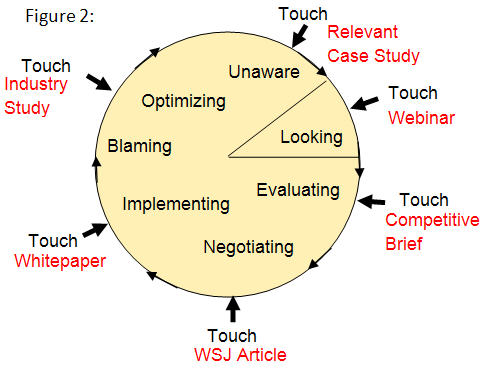Most sales processes discuss the buying cycle for complex sales. Customer Centric Selling identifies the “Looking” phase of this cycle in Figure 1 below as the 10% to 15 % of the market that may have a problem for which you have a product or service and who are actually looking for a solution to that problem. That’s not a very big slice of any market. In many markets today, the slice is even smaller.
Often sales and marketing teams subscribe to the “volume” theory in response to this problem. Call enough prospects and sooner or later you’ll hit on one who just happens to be looking. (Whether they’ll engage with you, however, depends on other factors.)
But what is the rest of the population doing? Some are evaluating your competitor’s offerings. Some are in negotiation and may need you for column fodder in order to get the best price from their preferred vendor in column A. Others are implementing, blaming, optimizing or perhaps even unaware. It’s a waste of time and resources to have expensive sales talent try to find that needle in a hay stack… “The Looking.” For the most part, they’re not very good at it, and it bores them. You can have your outbound market development team call, but that’s also a waste of time. So what do you do?
While this is not new marketing science, it bears repeating. Remember from my recent blog (Marketing and Sales Stuck in the ’90s) that 80% of customers now claim they find their vendors and not the other way around. Unless you have a “Net” presence and are making yourself known to your prospects regardless of where they are in their buying cycle, you are also wasting good time and effort. A very simple way to do this is to engage in an indirect conversation with them, either through email or on your website or blog. Provide them with information that is relevant, useful and timely throughout the buying cycle. You can also provide this information tailored to the type of buyer and their needs. If done correctly, you will either be the vendor making them aware of potential issues, or the vendor they choose to engage when they decide to look. There are a thousand subtleties to how to do this, but remember Quid pro Nada? Something for nothing. If you provide them with valuable information without asking for an immediate return, like in the movie Field of Dreams… “They will come.” Figure 2 is an example of the type of information that can be shared during a nurturing cycle.
On the average it takes 9 to 12 “touches” before much traction is gained. Even though it may look like it takes longer, it’s a bit like priming the pump. You’ll get a few results within a few touches and then the well will start producing and keep on flowing with less effort. The difference between sales and marketing is that sales wants instantaneous results. Marketing needs a little time. This is often a source of friction between the disciplines. Work it out. Sometimes it helps to give examples by introducing your sales team and your CEO to others who have done this successfully. A recent marketing campaign I ran using this process yielded a 20% market penetration and resulted in 30% growth.
There are numerous complexities to running a nurturing campaign, but there are a few essential elements: Tools, Contacts and Content, of which Content is King. More on these in upcoming blogs.



Pingback: Are You Still Trying to Find Prospects? | Prairie Sky Group